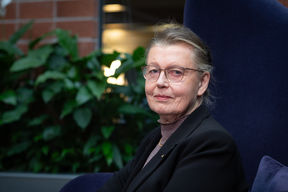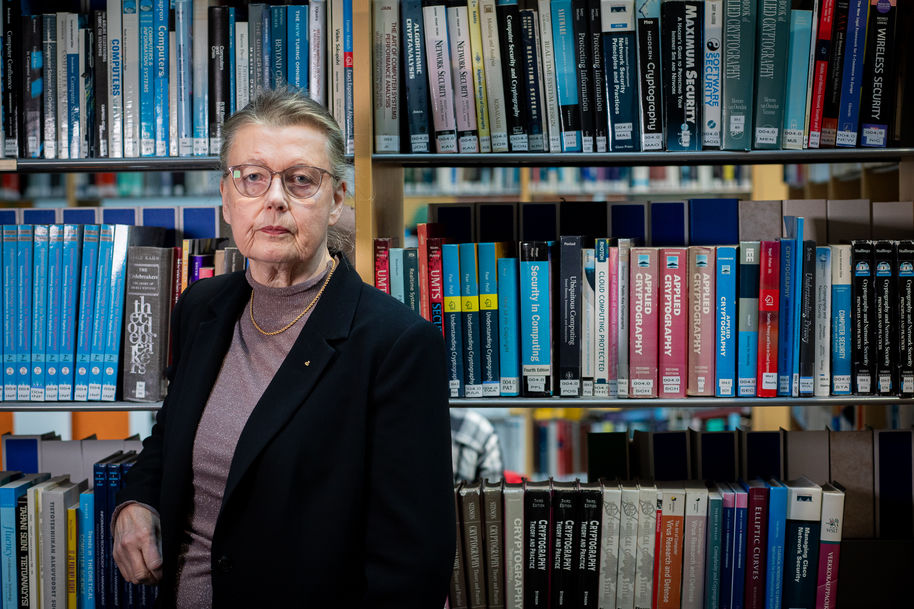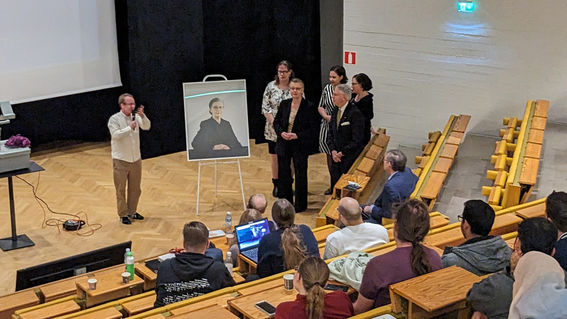Professor emerita Kaisa Nyberg receives Finnish Cultural Foundation award
Kaisa Nyberg was awarded for effective protection of information and secure communication.

In 1976, the US National Bureau of Standards published an encryption algorithm that was originally developed for banks. It was one of the first publicly available security protocols. The encryption algorithm marked the first steps of cryptology as a public field of research.
Meanwhile, 28-year-old PhD researcher Kaisa Nyberg was starting her doctoral thesis at the Department of Mathematics at the University of Helsinki. It dealt with functional analysis, which is a branch of mathematical analysis and studies spaces of functions as infinite-dimensional topological vector spaces. In other words, pure mathematics.
During and after her doctoral studies, Nyberg held temporary jobs as a lecturer and continued her research in functional analysis. She spent four years abroad with her diplomat partner René Nyberg on postings in the United States and Belgium. On her return to Finland, Nyberg felt that career prospects at the university had hit a wall.
‘There were no permanent positions in sight at the university, and my former seminar group had split up and each had gone their own ways,’ says Nyberg.
Nyberg met General Aimo Pajunen through her husband in 1987. Pajunen was the Chief of Staff of the Finnish Defence Forces (FDF) at the time. He encouraged Nyberg to apply for a researcher position in cryptography, because he felt there was an acute need for mathematicians in the FDF’s cryptology team.
According to Nyberg, her previous work was of little use in the new position, although her background gave a solid base for understanding cryptology.
‘I knew absolutely nothing about cryptology,’ says Nyberg with a chuckle. ‘I studied number theory and learned about the mathematics of electrical components using Boolean functions. Switching to practical problems was challenging at first, such as understanding the encryption schemes of field radios, which the FDF was acquiring at the time.’
Kaisa Nyberg, professor emerita, Aalto UniversityMost of all, I enjoyed teaching by doing things together with the students
Nyberg attended her first conference on cryptology in 1988. Back then, the field was going through a boom, quite similar to artificial intelligence research today.
‘The conference had the charm of a new discipline. People were enthusiastic and very nice - I quickly formed an international network and kept in close contact with them,’ says Nyberg. ‘One of my major research papers from those years dealt with the nonlinearity of Boolean functions which had been found to be a good property for the robustness of cryptographic algorithms. I found a constraint on perfect nonlinear functions, which makes them hard to exploit. Instead, I proposed to use almost perfect nonlinear (APN) functions, which do not have such a restriction.’
This constraint is now known as Nyberg's bound. The US National Security Agency (NSA) was also interested in Nyberg's research and invited her to give a full-day lecture to its researchers. ‘I didn't get any feedback on my lecture at the time,’ says Nyberg. ‘It wasn't until a good ten years later that I received indirect feedback. NSA’s research team had published a paper that provided a solution to an open question left out from my research, which was about the existence of APN functions.’
In 1992, the Nybergs, a family of five, were posted abroad to Bonn, which was West Germany’s capital at the time. Nyberg received a grant from the FDF’s scientific advisory board to continue her research.
‘Bonn was very close to other European capitals, so I could easily keep in touch with my international network. I continued my research and felt like a free artist during those years.’
When moving back to Finland, Nyberg found herself in a familiar state of mind.
‘I had reached the end of the road in theoretical Boolean function research. I was also quite alone with my research in Finland, which felt distant to where everything in cryptology research was happening at the time,’ says Nyberg.

In 1998, Nokia was on a roll. It overtook Motorola as the world's largest mobile phone manufacturer and controlled about a third of the global mobile phone market. Nokia's influence also led it to become part of 3GPP, the international organisation that defines the technical rules for information and communication technologies.
To leverage its success, Nokia was on a recruitment spree. It was looking for the best talent out there. Nyberg's mathematician friend Valtteri Niemi had just joined the Nokia Research Centre, where he worked on mobile phone security systems as a part of an international team of experts. Nyberg felt the attractiveness of international industry experience and chose to apply for a position.
When Nyberg joined Nokia in 1998, the company had already started to develop its 3G network.
‘Our goal was to make the best possible encryption algorithms for transferring data in 3G networks,’ says Nyberg. ‘I was also Nokia’s representative in the 3GPP’s encryption group. Today, its quite normal for students from Aalto to build careers in big technology companies, but back then, working with companies like Microsoft was still very new and exciting.’
At Nokia, Nyberg made one of the most technically significant breakthroughs of her career.
‘My colleague N. Asokan and I developed a new pairing method for Bluetooth devices at Nokia and standardised it with Microsoft’s cryptologists. The solution is still used in billions of Bluetooth devices around the world,’ says Nyberg.
The importance of cryptology as a fundamental research field for internet and mobile network security was quite well understood in Finland. In 1997, a professorship in cryptology was established at the Helsinki University of Technology (TKK, predecessor to Aalto University). Nyberg had also been invited to apply for the position, but at the time she was more interested in getting industry experience. However, she continued to teach a cryptology course at TKK during her Nokia years.
In 2004, the professorship of cryptology at TKK opened up again.
‘I got a call from the Head of the Laboratory for Theoretical Computer Science and was encouraged to check out the open professorship,’ says Nyberg.
This time Nyberg decided to apply. ‘I felt that I had what it took to be successful as a professor.’
‘When Kaisa joined TKK as a professor in 2005, she brought diversity to a very male-dominated work community in many ways,’ says Ilkka Niemelä, President of Aalto University, Professor of Computer Science and then Head of the Laboratory. ‘Kaisa was an internationally recognised expert, especially in the development of block cryptography and mobile phone security. She had an extensive international network and a wide range of work experience also outside the academic world.’
In addition to new avenues for research, the professorship brought new responsibilities in teaching. Nyberg continued and further developed her course in cryptology. She also established her own research group and became involved with training researchers.

‘Most of all, I enjoyed teaching by doing things together with the students – just as I had learnt to navigate at sea as a child with my father, and to sew clothes with my mother. I guess doing things together is my pedagogical approach to being an instructor. The instructor has more experience and insight, maybe even knowledge, and should use it to work together with the students.’
For Nyberg, the most meaningful memories of her career as a professor are mentoring talented young researchers. ‘My greatest impact on society comes through the students I have mentored. When they moved on to industry or continued in academia, I wanted to make sure they have good baseline knowledge, which they could then use later in life to develop the world-class cryptology tools.’
Nyberg's students have indeed gone on to a wide range of cryptology jobs or continued their academic careers.
‘Kaisa is a demanding teacher and mentor, but she demands even more from herself. This is also how she endured the very male-dominated world of university mathematics in the 70s and 80s,’ says Nyberg’s former PhD researcher who now works in cryptology for a governmental organisation. ‘She is able to make sure that the student can concentrate on research. She has a broad understanding of cryptology and its subfields and hence, Kaisa also has a good idea of suitable and productive research topics. Throughout her career, Kaisa has created encryption products or principles that are still in use today.’
It has been almost half a century since the first public encryption algorithm as well as the introduction of home computers to consumer markets. The world around us has become digitalised to the point, where it is sometimes impossible to separate the digital from our physical lives. People's privacy is also under constant pressure around the world.
Cryptology research and commercialisation has brought digital security accessible to ordinary citizens and society, and now constitutes an estimated $200 billion market annually. Kaisa Nyberg's career shows that when opportunity and competence meet, a single person can make a significant contribution in the development of complex systems.
’All encryption algorithms in mobile networks that were developed before Kaisa came to Nokia have been more or less breached. It's perhaps no coincidence that the algorithms we developed after Kaisa joined us have never been broken,’ says Valtteri Niemi.
Kaisa Nyberg was awarded for effective protection of information and secure communication.

Kaisa Nyberg has researched mathematical methods of securing information and communications against active attackers.



